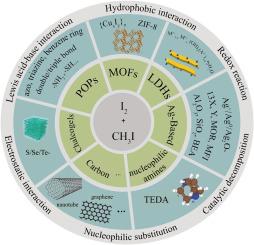当前位置:
X-MOL 学术
›
Nano Today
›
论文详情
Our official English website, www.x-mol.net, welcomes your feedback! (Note: you will need to create a separate account there.)
Host-guest interaction-mediated nanointerface engineering for radioiodine capture
Nano Today ( IF 17.4 ) Pub Date : 2020-12-03 , DOI: 10.1016/j.nantod.2020.101034 Juan Wang , Daoqing Fan , Chunhuan Jiang , Lehui Lu
Nano Today ( IF 17.4 ) Pub Date : 2020-12-03 , DOI: 10.1016/j.nantod.2020.101034 Juan Wang , Daoqing Fan , Chunhuan Jiang , Lehui Lu

|
Nuclear power plants are expanding rapidly around the world to meet the growing energy demands. The effective capture of volatile radioiodine is an important area of research that is associated with the reprocessing of used nuclear fuel. However, the construction of high-performance adsorbents depends largely on an in-depth comprehension of the underlying binding mechanism at the gas-solid interface. Recently, a growing number of studies have demonstrated the pivotal role of optimizing the interface properties and binding sites, thereby regulating the interaction between the host (adsorbent) and guest (iodine) molecules. In this review, we first introduce the present understanding of the main mechanism for removing volatile radioiodine, and give more detailed descriptions of the capture pathways of specified adsorbents. Then, we discuss nanointerface engineering in materials, which have been conducted in various studies, and review the result of recent studies. Finally, nanointerface engineering based on the adjustment of host-guest interactions are summarized, and future research directions are presented.
中文翻译:

用于放射性碘捕获的主客体相互作用介导的纳米界面工程
核电站正在世界各地迅速扩张,以满足不断增长的能源需求。有效捕获挥发性放射性碘是与废核燃料后处理相关的一个重要研究领域。然而,高性能吸附剂的构建很大程度上取决于对气固界面潜在结合机制的深入理解。最近,越来越多的研究证明了优化界面特性和结合位点的关键作用,从而调节主体(吸附剂)和客体(碘)分子之间的相互作用。在这篇综述中,我们首先介绍了目前对去除挥发性放射性碘的主要机制的理解,并对特定吸附剂的捕获途径进行了更详细的描述。然后,我们讨论了各种研究中进行的材料纳米界面工程,并回顾了最近的研究结果。最后,对基于主客体相互作用调节的纳米界面工程进行了总结,并提出了未来的研究方向。
更新日期:2020-12-03
中文翻译:

用于放射性碘捕获的主客体相互作用介导的纳米界面工程
核电站正在世界各地迅速扩张,以满足不断增长的能源需求。有效捕获挥发性放射性碘是与废核燃料后处理相关的一个重要研究领域。然而,高性能吸附剂的构建很大程度上取决于对气固界面潜在结合机制的深入理解。最近,越来越多的研究证明了优化界面特性和结合位点的关键作用,从而调节主体(吸附剂)和客体(碘)分子之间的相互作用。在这篇综述中,我们首先介绍了目前对去除挥发性放射性碘的主要机制的理解,并对特定吸附剂的捕获途径进行了更详细的描述。然后,我们讨论了各种研究中进行的材料纳米界面工程,并回顾了最近的研究结果。最后,对基于主客体相互作用调节的纳米界面工程进行了总结,并提出了未来的研究方向。



























 京公网安备 11010802027423号
京公网安备 11010802027423号